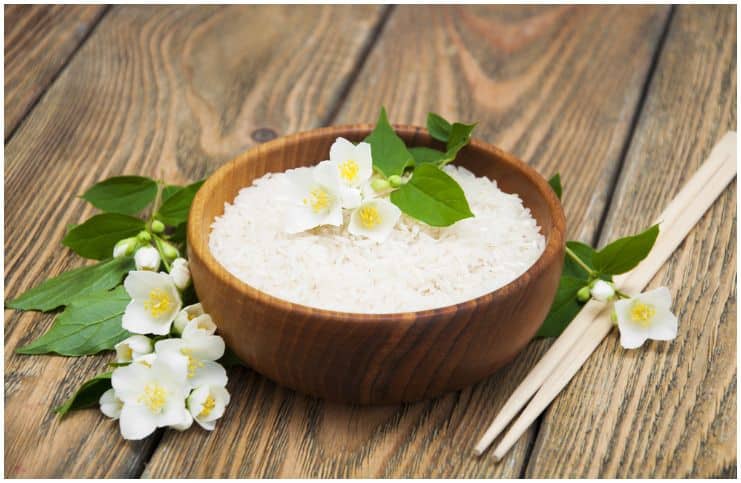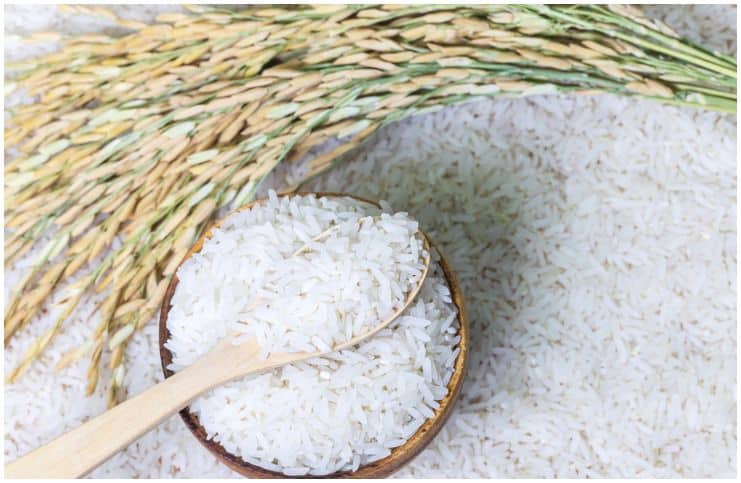Jasmine rice, also known as aromatic rice, is a long-grain variety of fragrant rice. It has a slightly sticky and soft texture when cooked.
It is the most popular rice throughout Southeast Asia and in Thailand and it is sold in both brown and white varieties, however, the brown rice is richer in nutrients than the white one.
Nutritional Value
This type of rice is a good source of dietary fiber, minerals (such as – iron, zinc, manganese, magnesium, potassium, phosphorus, selenium, and molybdenum), vitamins (like – thiamine, niacin, pantothenic acid, pyridoxine, and folate) and it has all the essential amino acids.
Health Benefits of Jasmine Rice

Good for people with celiac disease
Rice is naturally gluten-free. Gluten is a special type of protein that is found in certain grains (especially wheat). Gluten is perfectly natural, nevertheless, individuals with gluten intolerance, celiac disease, or dermatitis herpetiformis (a rare skin condition), may experience severe adverse effects if they eat it.
For instance, in patients with celiac disease, this protein irritates the lining of the small intestine and causes the immune system to attack the villi, that may be destroyed or damaged.
Boosts the immune system
Vitamin B1, also known as thiamine, is a coenzyme used by the body to maintain proper heart function and nerve function and to metabolize food for energy. Vitamin B1 s frequently called an anti-stress vitamin due to its strong capacity to protect the immune system. A deficiency of vitamin B1 may cause two important health problems: Wernicke-Korsakoff syndrome and beriberi (which affects eye movements, breathing, alertness, and heart function).
100g contains 0,2 mg or 14 percent vitamin B1 of the recommended daily intake.
Prevents iron anemia
Iron is a mineral vital for healthy skin, hair, and nails. Iron deficiency anemia is commonly caused when there’s not enough of this mineral in your red blood cells. Without adequate levels of iron, your red blood cells cannot sufficiently provide oxygen to your tissues and cells.
Iron is also required for muscle movement due to the fact that it helps store the oxygen in muscles allowing them to strengthen and move.
Note – iron-deficiency anemia should not be confused with megaloblastic anemia that results from an inadequate intake of vitamin B12 and folate.
100g contains 1,2 mg or 15 percent iron of the recommended daily intake.
Bone health
Manganese is a mineral that plays a central role in a number of physiologic processes as an activator of other enzymes or as a constituent of numerous enzymes. When manganese is combined with the right amounts of zinc, calcium, and copper, it promotes normal bone density, particularly in the legs and spine.
Considering these important functions, having a diet with foods rich in manganese is essential to make sure that these functions will go correctly in your physical body.
100g contains 0,5 mg or 21 percent manganese of the recommended daily intake.
Brain function

More than one hundred enzyme reactions involved in metabolism are produced by the body with the help of vitamin B6. Furthermore, vitamin B6 helps cells maintain and make DNA and promotes the growth of red blood cells.
Vitamin B6 helps to reduce the risk of birth defects. For example, according to research, a deficiency in this vitamin may influence negatively memory function and increases the chance of neurodegenerative diseases to occur.
Moreover, individuals with asthma can benefit from consuming foods rich in vitamin B6. Recent studies of the nutrient concluded that asthma attacks decrease in frequency and severity during a diet high in vitamin B6.
100g contains 0,1 mg or 7 percent vitamin B6 of the recommended daily intake.
Improves blood flow
Selenium is a trace element that is important to numerous physiological functions, including helping the thyroid to produce hormones and protecting cells from oxidative stress. It is also considered that this can maintain heart health, due to its potent capacity to increase blood flow, fight inflammation, and help with antioxidant activity. In addition, adequate intake of selenium lowers the risk of prostate, colorectal, and lung cancer.
100g contains 7,5 µg or 14 percent selenium of the recommended daily intake.
Red blood cells production
Vitamin B9, better known as folate, is an important member of the B-complex vitamin group. Adequate vitamin B9 intake is important during periods of rapid growth, like – infancy, pregnancy, and adolescence. More importantly, vitamin B9 is essential in the development of erythrocytes or red blood cells. A lack of folate can make the body susceptible to different types of cancer.
Note – folic acid is the synthetic version of folate. Side effects of folic acid include – trouble concentrating, changes in sex hormones, mood changes, inability to sleep, and deficiencies in certain nutrients such as – vitamin B12.
100g contains 25,6 µg or 25 percent folate of the recommended daily intake.
Detoxes the body through excretion and urination
Phosphorus makes up about 1% of an adult body and about 0.5% of an infant’s body and is considered the 2nd most abundant element in the human body. Phosphorus helps in keeping the kidney healthy and its functions active. Furthermore, it helps the breakdown of minerals and vitamins by releasing the potential energy stored inside the food you ingest.
Note – excess intake of phosphorus may lead to a formation of mineral deposits in your muscles, a hardening of organs and soft tissue, and an imbalance in other essential minerals, such as – zinc, iron, and magnesium.
100g contains 43 mg or 6 percent phosphorus of the recommended daily intake.
Can reduce hunger levels and appetite
Protein is used in every single cell of the human body and is vital for supporting neurological function, helping to balance hormones naturally, building muscle mass, aiding in digestion, and keeping our mood upbeat. According to research, consuming foods high in protein is by far the most filling.
100g contains 2,7 g or 5 percent complete protein of the recommended daily intake.
Selection and storage
Inspect rice for discoloration or insects, prior to preparing for home storage. Purchase quality rice grains from a trusted source.
To maximize the shelf life of rice, store in a cool dry area. Leftover rice keeps well in the fridge for a few days.
Cooking tips
- Before cooking it’s important to wash the rice to remove any excess starch and dust.
- To cook this type of rice, use a 2 to 1 ratio. Boil 2 cups of water in a small saucepan with a tight-fitting lid, add 1 cup of rice and reduce heat.
- Don’t stir the rice throughout the cooking – it will make it stodgy.
Vegan jasmine rice salad recipe (oil-free)
Ingredients
- 2 cups of rice;
- 1 tsp turmeric;
- 4 cups of water;
- 1 tsp coriander;
- 4 onions, finely diced;
- 4 tomatoes;
- 2 tbs sunflower seeds;
- 1 bell pepper;
- a handful of fresh herbs, like parsley, basil, and mint;
- pepper and Himalayan salt;
- 1 tsp freshly squeezed lemon juice.
Method
Cook the rice in plenty of boiling water for half an hour or until just tender to the bite. Drain well and set aside to cool completely.
Dice tomatoes and bell pepper and then scatter over the rice, along with the onions, sunflower seeds, turmeric, coriander, and the fresh herbs in a salad bowl. Season with pepper and salt and toss well.
Side Effects of Jasmine Rice
There are no known side effects.
Featured image credits – SURAKIT SAWANGCHIT/Shutterstock
References http://lpi.oregonstate.edu/mic/minerals/manganese https://ods.od.nih.gov/factsheets/VitaminB6-Consumer/ https://www.ncbi.nlm.nih.gov/pmc/articles/PMC3218540/
